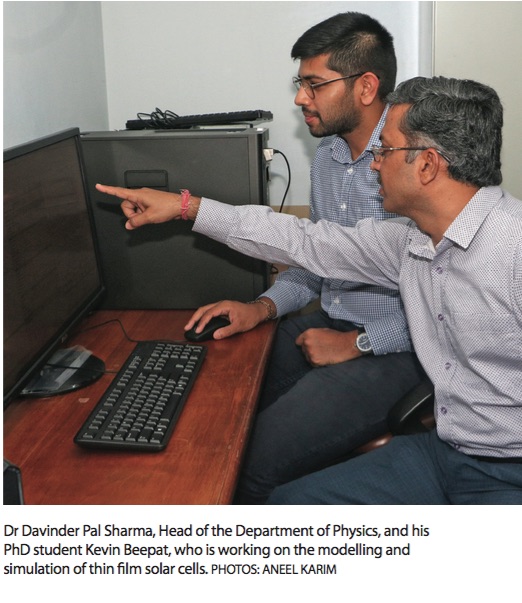UWI St Augustine’s Physics Department is engaged in research to unlock the future of Renewable Energy for the Caribbean and the world
Estimates by the International Energy Agency have projected that renewable energy sources will account for 35 percent of the world’s power generation by 2035.
As the world continues its shift towards renewable energy, a team of lecturers at UWI St Augustine’s Department of Physics at the Faculty of Science and Technology are researching how current and emerging renewable energy technologies can be made more efficient to better serve the Caribbean’s needs.
In a recent interview, the department’s head, Dr Davinder Sharma, said they are focused on this particular research because of the goals set by the United Nations Framework Convention on Climate Change (UNFCCC) to reduce global carbon emissions and limit global warming.
Trinidad and Tobago, like many other Caribbean countries, is a signatory to numerous UNFCCC frameworks. Dr Sharma believes it is important that the department contribute to the region’s efforts.
Leading by example, he is currently researching how the electricity generation process in microbial fuel cells (MFCs) can be optimised by using wastewater – from different sources in Trinidad and Tobago – as a fuel source.
To determine which wastewater sample will be more efficient, the samples are being tested in MFCs using different types of MFC structures – proton exchange membranes, mediators, anode materials, and cathode materials, with different shapes and sizes. Use of nanoparticles in various sections is also being explored.

“In the United States, particularly in San Diego, there is a wastewater treatment plant which is using microbial fuel cells to generate electricity for over one hundred homes,”he explained.
Currently, hydrogen powered fuel cells are the most popular types of fuel cells on the energy market, but MFCs are emerging as a more sustainable energy source.
In MFCs, wastewater is used as a fuel source instead of hydrogen.
Since the MFCs research started in 2015, Sharma and his students have tested a variety of wastewater samples from both residential and industrial areas.
“My students have collected many different samples from residential areas, farms, swamps, and breweries, to find out which is the best substrate [material from which fuel can be obtained] for electricity generation,” he said. “What we are also trying to see is if we have specific types of microbes in Trinidad and Tobago which can help generate more electricity.”
Also working to improve existing renewable energy sources in the region is Dr Dinesh Pathak.
A material science lecturer at the UWI St Augustine Physics Department since 2021, Dr Pathak has been researching the structure-property correlation of thin-film solar panels.

In doing so, he’s able to determine which of the many thin-film materials used to create these panels will have the best potential to be used in solar cells to capture and store energy for conversion into electricity.
Since the creation of photovoltaics (solar technology), Pathak said, silicon has been one of the most popular, widespread, and durable materials for solar cells. But over the years, other forms of solar technology like thin-film solar cells have been developed.
“At the Physics Department, we have a lab dedicated to exploring new materials,” he explained. “By preparing the thin-film in many methods – like spin coating, deep coating, or the spray method – we try to see the properties of those thin layers and if they are suitable to capture the solar spectrum.” Compared to silicon panels, said Pathak, some thin-film panels are less expensive and more efficient because of their micro and macro structures.
Ultimately, he will continue to identify and recommend materials that can make solar panels more efficient and inexpensive.
Dr Vinod Kumar has also been conducting research on different types of dye-sensitised solar cells, perovskite (a calcium titanium oxide mineral) solar cells, and organic solar cells.
Dr Kumar explained, “Part of what we are doing to test these materials is looking at the different ways they can be structured in the devices to improve energy processing and distribution.”

He added, “For example, in the third generation cells, we are looking at layering materials unlike the single layers in some other generations of technologies. So, we are working on the architecture of these devices and how they can be modified to improve device efficiency with the collaboration of different research groups worldwide.”
To date, Dr Kumar said the efficiency of these third generation solar cells are already competing with the current widely used commercial silicon-based first generation solar cells and thin-film based second generation solar cells.
Not only are these cells efficient, they are also less expensive.
“I am working on these third generation solar cells because I believe that, in the future, these will replace existing technologies worldwide,” he explained.
‘I believe that, in the future, these will replace existing technologies worldwide.’
As part of the Physics Department’s ongoing research, all three academics, led by Dr Sharma, are collaborating to work with a PhD student on the modelling and simulation of thin-film solar cells.
Reflecting on the worldwide shift to renewable energy and sustainability, Kumar said the department’s research helps the region have more options to embrace these technologies and give students the skills to be able to contribute to this shift.
Dr Sharma is hopeful the technologies discovered through their work will be used to diversify the energy streams of the Caribbean and the world.
He said, “In the end, we can save money, material, time, and benefit the environment if we first do modelling and simulation to identify optimum structures and materials for the solar cells to get maximum efficiency.”